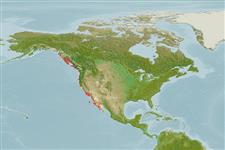Environment: milieu / climate zone / depth range / distribution range
Ecologia
marinhas; oceanódromo (Ref. 51243); intervalo de profundidade 0 - 18 m (Ref. 2850). Temperate; 58°N - 24°N, 155°W - 111°W
Eastern Pacific: Alaska to Magdalena Bay, Baja California. Not common north of Point Conception (Ref. 11484).
Tamanho / Peso / Idade
Maturity: Lm ? range ? - ? cm
Max length : 145 cm FL macho/indeterminado; (Ref. 40637); peso máx. Publicado: 12.0 kg (Ref. 40637); Idade máx. registada: 12 anos (Ref. 56049)
Espinhos dorsais (total): 6; Raios dorsais moles (total): 9-10; Espinhos anais 1; Raios anais moles: 8 - 9. Color bluish or brownish dorsally, silvery ventrally (Ref. 6885).
Usually near shore or near the surface (Ref. 2850). Often in small schools (Ref. 2850). Young enter bays (Ref. 2850). Feed mainly on other fishes (Ref. 2850). Pelagic spawners (Ref. 56049). Migrate south from the California coast during autumn, but may remain in front of the Mexican coast throughout the year (Ref. 9345). Utilized fresh, dried or salted and frozen; eaten broiled and baked (Ref. 9988). Considered as potentially dangerous due to its large, sharp teeth and aggressive disposition, though there are no reports of attacks (Ref. 9988).
Pelagic spawner (Ref. 56049).
Eschmeyer, W.N., E.S. Herald and H. Hammann, 1983. A field guide to Pacific coast fishes of North America. Boston (MA, USA): Houghton Mifflin Company. xii+336 p. (Ref. 2850)
Categoria na Lista Vermelha da IUCN (Ref. 130435)
Warning: mysqli::__construct(): (HY000/1040): Too many connections in /var/www/html/includes/func_getlabel.php on line 46
Can't connect to MySQL database (fbapp). Errorcode: Too many connections
